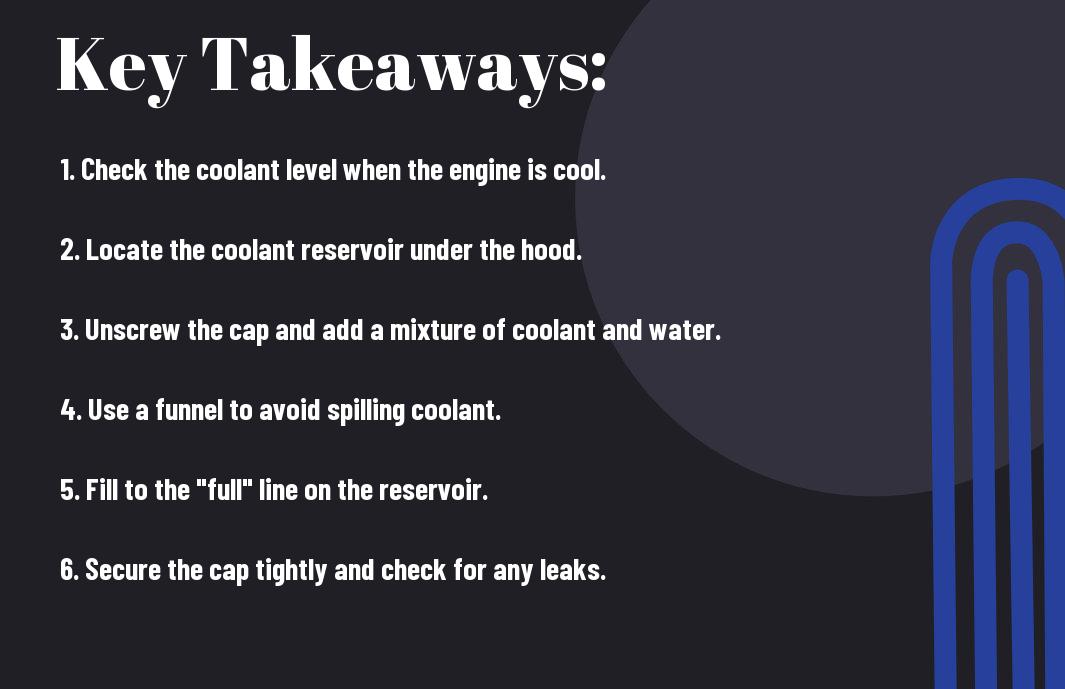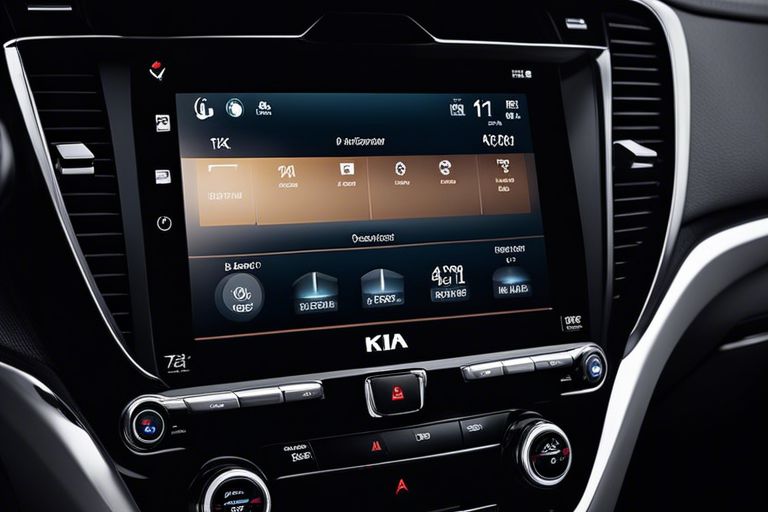Ensuring that your car’s cooling system is functioning properly is essential for preventing overheating and potential engine damage. In this blog post, I will walk you through the simple steps of adding coolant to your car, and discuss the importance of regular coolant maintenance. It’s crucial to remember that neglecting your car’s cooling system can lead to costly repairs and even a breakdown on the side of the road. By following these guidelines, you can keep your car running smoothly and avoid any unforeseen issues.
Key Takeaways:
- Choosing the Right Coolant: Ensure the coolant you select is compatible with your car’s make and model to prevent damage to the engine.
- Checking Coolant Levels: Regularly monitor the coolant level in the reservoir and top it up when necessary to prevent overheating.
- Following Safety Precautions: Always let the engine cool down before opening the radiator cap and handle coolant with care to avoid burns or spills.
- Properly Bleeding the System: Remove air bubbles from the coolant system by following the correct bleeding procedure to maintain efficient cooling.
- Keeping Up with Maintenance: Regularly adding coolant is just one part of proper vehicle maintenance – be sure to also schedule regular maintenance for your car’s cooling system.

Importance of Proper Engine Coolant Levels
For proper vehicle maintenance, it is crucial to ensure that your engine coolant levels are always at the appropriate mark. Failure to maintain the right coolant levels can lead to serious engine damage and potential breakdowns. Regularly checking and topping up your engine coolant is essential to keep your vehicle running smoothly and preventing costly repairs. If you are unsure how to top up your radiator coolant, you can find a detailed guide here.
Understanding the Role of Coolant in the Vehicle
Coolant plays a critical role in maintaining the operating temperature of your vehicle’s engine. It helps to regulate the engine’s temperature, preventing it from overheating or freezing. The coolant also serves as a corrosion inhibitor, protecting the metal components of the cooling system from rust and corrosion. Without proper coolant levels, the engine can overheat, leading to potential damage to vital engine components.
Consequences of Low Coolant Levels
Having low coolant levels in your vehicle can lead to severe consequences. The engine could overheat, causing irreparable damage to important parts like the cylinder head gasket, cylinder walls, and pistons. In extreme cases, a lack of coolant can even lead to a complete engine failure, leaving you stranded on the side of the road. Additionally, inadequate coolant levels can result in reduced fuel efficiency and increased emissions, which can be harmful to the environment. It is crucial to keep a close eye on your coolant levels to prevent these potentially dangerous and costly issues.
How to Check Coolant Levels
Clearly, checking your car’s coolant levels is an important part of vehicle maintenance. Coolant is essential for keeping your engine at the right temperature and preventing it from overheating. Low coolant levels can lead to serious engine damage, so it’s crucial to regularly check and top up your coolant as needed.
Location of Coolant Reservoir
When it comes to checking your coolant levels, the first thing you need to do is locate the coolant reservoir. This is typically a translucent plastic tank located near the radiator. It has markings indicating the minimum and maximum levels of coolant. The reservoir may have a pressurized cap to keep the coolant system under pressure, so be cautious when opening it, especially if the engine is hot.
Proper Method for Checking Coolant Levels
Once you’ve located the coolant reservoir, you can check the coolant levels by visually inspecting the markings on the side of the reservoir. It’s important to do this when the engine is cold, as opening the reservoir cap when the engine is hot can lead to serious burns from escaping steam and hot coolant. If the coolant level is below the minimum mark, it’s time to add more coolant to prevent potential engine damage.
As a car owner, regular maintenance is crucial to keep your vehicle in top condition. One essential task is adding coolant to your car’s engine to prevent it from overheating. Here’s a guide on how to do it properly.
Steps to Add Coolant to a Car
Your car’s engine requires the right amount of coolant to maintain the optimal temperature and prevent it from overheating. Here are the steps to add coolant to your car:
Choosing the Right Coolant for Your Vehicle
When it comes to choosing the right coolant for your vehicle, it’s important to refer to your car’s owner’s manual to determine the specific type of coolant recommended by the manufacturer. Some vehicles require a specific type of coolant, such as green, red, or orange, while others may be compatible with universal coolants. It’s crucial to ensure that the coolant you choose is compatible with your car’s engine to avoid any potential damage.
Step-by-Step Guide to Adding Coolant
Adding coolant to your car is a simple process that can be done in a few straightforward steps. Follow the guide below for adding coolant to your vehicle:
| Steps to Add Coolant | Additional Tips |
| 1. Park your car on level ground and allow the engine to cool down. | It’s important to add coolant to a cool engine to avoid any potential burns or injuries. |
| 2. Locate the coolant reservoir and check the current coolant level. | Ensure that the coolant level is below the maximum mark to avoid overflowing. |
| 3. Open the coolant reservoir cap and fill it with the appropriate coolant mixture. | Use a funnel to prevent spills and make sure to use the correct coolant-to-water ratio. |
| 4. Close the reservoir cap tightly and start the engine to check for any leaks. | If there are any leaks, address them immediately to prevent coolant loss and potential engine damage. |
| 5. Monitor the coolant level over the next few days to ensure it remains at the appropriate level. | If the coolant level drops significantly, it may indicate a potential leak that needs to be addressed. |
Maintenance Tips for Keeping Coolant Levels in Check
Despite the importance of coolant in maintaining the proper operating temperature of your vehicle, it can often be overlooked. To keep your car running smoothly, it is vital to regularly monitor and maintain coolant levels. Here are some essential tips to help you keep your coolant in check:
- Regular Inspections and Top-Ups: Checking your coolant levels regularly and topping up when necessary is crucial for preventing engine overheating and potential damage.
- Professional Coolant Flushes and Replacements: Having your coolant system flushed and replacing it at recommended intervals ensures optimal performance and prevents corrosion and buildup.
Knowing how to maintain proper coolant levels can save you from costly repairs and ensure the longevity of your vehicle.
Regular Inspections and Top-Ups
Regularly inspecting your coolant levels is a simple yet effective way to ensure your vehicle’s engine is running at the appropriate temperature. To do this, locate the coolant reservoir and check the coolant levels against the markings on the reservoir. If the levels are low, top up with a mixture of coolant and water as recommended by your vehicle’s manufacturer. This simple task can prevent overheating and potential engine damage.
Professional Coolant Flushes and Replacements
Having your vehicle’s coolant system flushed and replacing the coolant at recommended intervals is crucial for maintaining optimal performance and preventing corrosion and buildup within the system. A professional coolant flush ensures that any contaminants or debris are removed, and fresh coolant is added to the system, promoting efficient heat transfer and protecting the engine from overheating and damage. I recommend following the manufacturer’s guidelines for coolant replacement to keep your vehicle running smoothly and prevent costly repairs down the line.

How to Add Coolant to a Car – Vehicle Maintenance Essentials
Presently, I hope you have gained a better understanding of the importance of adding coolant to your car and the steps involved in doing so. Proper vehicle maintenance is essential for keeping your car running smoothly and efficiently, and adding coolant is a simple yet crucial aspect of this. By following the steps outlined in this guide, you can ensure that your car’s engine stays cool and performs at its best. Remember to always check your coolant level regularly and top it up as needed to avoid any potential damage to your vehicle. Your car will thank you for it!
FAQ – How to Add Coolant to a Car – Vehicle Maintenance Essentials
Q: Why is it important to add coolant to my car?
A: Coolant is essential for regulating the temperature of your car’s engine. Without it, your engine could overheat, leading to serious damage and expensive repairs.
Q: When should I add coolant to my car?
A: It is important to regularly check your coolant levels and top it up as needed. You should also completely replace your coolant according to your vehicle manufacturer’s recommended schedule.
Q: Where do I add coolant to my car?
A: Your car’s coolant reservoir is usually a transparent plastic tank located near the radiator. Refer to your owner’s manual for the exact location in your vehicle.
Q: What type of coolant should I use for my car?
A: It is important to use the correct type of coolant as specified by your vehicle manufacturer. Typically, this will be a 50/50 mixture of coolant and distilled water, but always refer to your owner’s manual to be certain.
Q: Should I add coolant when the engine is hot or cold?
A: It is safest to add coolant to a completely cooled engine. Do not attempt to open the coolant reservoir cap when the engine is hot, as this can lead to burns from escaping steam and hot coolant.









Leave a comment